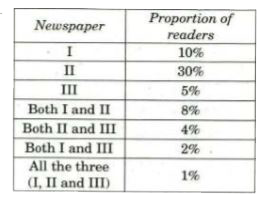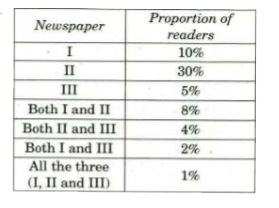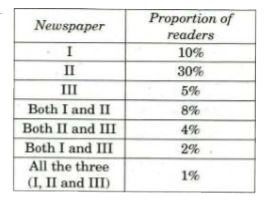In a town 34.5% of the people are not literates 27% have education up to primary school, 18.6% have education up to middle school. The people with education up to high school are twice the number of people with education up to Pre-University. Of the remaining, 660 are graduates. If the population of the town is 15000, then what is the number of people with education up to high school?
3120
1560
1550
None of these
The correct Answer is:C
To solve the problem, we will break it down step by step.
Step 1: Calculate the number of people who are not literates.
The population of the town is 15,000. The percentage of people who are not literates is 34.5%.
Number of not literates=34.5100×15000=5175
Step 2: Calculate the number of people with education up to primary school.
The percentage of people with education up to primary school is 27%.
Number of primary school educated=27100×15000=4050
Step 3: Calculate the number of people with education up to middle school.
The percentage of people with education up to middle school is 18.6%.
Number of middle school educated=18.6100×15000=2790
Step 4: Calculate the total number of people accounted for so far.
Now, we will add the number of people in each category we have calculated so far.
Total accounted=5175+4050+2790=12015
Step 5: Calculate the number of remaining people.
To find the remaining number of people, we subtract the total accounted from the total population.
Remaining people=15000−12015=2975
Step 6: Determine the number of graduates.
We know that there are 660 graduates among the remaining people.
Step 7: Calculate the number of people with education up to high school and pre-university.
Let x be the number of people with education up to Pre-University. Then, the number of people with education up to High School is 2x.
The total number of people with education up to High School and Pre-University is:
x+2x=3x
Step 8: Set up the equation for the remaining people.
The remaining people consist of graduates, those with education up to High School, and those with education up to Pre-University.
3x+660=2975
Step 9: Solve for x.
3x=2975−660
3x=2315
x=23153≈771.67
Since x must be a whole number, we round down to 771.
Step 10: Calculate the number of people with education up to High School.
Now we can find the number of people with education up to High School:
Number of high school educated=2x=2×771=1542
Final Answer:
The number of people with education up to high school is 1542.
---
The population of the town is 15,000. The percentage of people who are not literates is 34.5%.
The percentage of people with education up to primary school is 27%.
The percentage of people with education up to middle school is 18.6%.
Now, we will add the number of people in each category we have calculated so far.
To find the remaining number of people, we subtract the total accounted from the total population.
We know that there are 660 graduates among the remaining people.
Let x be the number of people with education up to Pre-University. Then, the number of people with education up to High School is 2x.
The remaining people consist of graduates, those with education up to High School, and those with education up to Pre-University.
3x=2975−660
3x=2315
x=23153≈771.67
Now we can find the number of people with education up to High School:
The number of people with education up to high school is 1542.
Topper's Solved these Questions
Similar Questions
In a village if 1/5th part is uneducated and number of people educated is 2000 , then find the population of the village.
View SolutionIn a certain town of population size 1,00,000 three types of newspapers (f, II and Ill) are available. The percentages of' the people in the town who read these papers are as follows :

What is the number of people who read only one newspaper ?
View Solution
Knowledge Check
In a town 34.5% of the people are not literates 27% have education up to primary school, 18.6% have education up to middle school. The people with education up to high school are twice the number of people with education up to Pre-University. Of the remaining, 660 are graduates. If the population of the town is 15000, then what is the number of people with education up to high school?
A3120B1560C1550DNone of theseIn a co-educational school there are 15 more girls than boys. If the number of girls is increased by 10% and the number of boys is also increased by 16% there would be 9 more girls than boys. What is the number of students in the school?
A140B125C265D255The Indian education sector is one of the largest sunrise sectors contributing to the country's economic and social growth. The Indian education system, considered as one of the largest in the world, is divided into two major segments of core and non-core businesses. While, schools and higher education form the core group, the non-core business consists of pre-schools, vocational traiking and coaching classes. The education sector in India is evolving, led by the emergence of new niche sectors like vocational training, finishing schools, child-skill enhancement and e-learniti.g. India has emerged as a strong potential market for investments in training and education sector, due to its favourable demographics (young population) and being a services-driven economy. Indian education sector's market size in Financial Year, 2012-13 estimated to be USD 71.2 billion is expected to increase to USO 109.8 billion by Financial Year 2015-2016 due to the expected strong demand for quanity education. The market .grew at a CAGR of 16.51/o durmg Financial Year 2015-2016. Financial Year 2005-2012.
Education has been made an important and integral part of the national development efforts . . The tremendous increase in the num-ber of students and of educational institutions has given rise to the term 'equcation explosion'. No doubt, th.is has resulted in serious problems such as inadequacy of financial resources and infrastructure and dilution of personal attention to the education and character-formation of the students. Also there is the unwanted side-effect of enormous increase in the number of educated unemployed. However, we cannot overlook the advantages o.f education explosion in India. Mere increase in the percentage ofliterate people does not indicate a qualitative change in the educational standards of the people and a substantial · improvement in manpower resources of India. Unemployment problem in India cannot be blamed on the availability of large masses of educated people in India.
Uncertainty and vacillation have marked the government's policy regarding the medium of education in India. While the government policy in this respect has not changed, a significant increase in the number of schools-primary and secondary-imparting education through the English medium is a significant development: thousands of nursery schools that have mushroomed since the last decade purport to impart education to infants through English. This is an unwanted development which has been deprecated by educationalists and political leaders. Regarding the medium of instruction in colleges and universities, many State Governments have already decided, in principle, to switch over to the regional language. However the implementation in this respect has remained very slow.
Today virtually every university in India is offering correspondence courses for different degrees and diplomas. In fact correspondence education has opened new vistas for the educational system which could not successfully meet the challenging problem of providing infrastructure for multitudes o( new entrants into tlie portals of higher education. The public demand for higher education was·initially met through evening colleges, now correspondence education has come to the rescue of the worried education administrators.
Which of the following explains the term 'education · explosion' as per the passage?
A. Huge investment in the education sector.
B. Pro-active Govem1~1ent policy towards the education sector.
C. Spurt in the number of students and educational institutionsABoth(A)and(B)BOnly (C)CBoth (B) and (C)DOnly(B)
In a certain town of population size 1,00,000 three types of newspapers (f, II and Ill) are available. The percentages of' the people in the town who read these papers are as follows :

What is the number of people who read at least two newspapers ?
View SolutionIn a certain town of population size 1,00,000 three types of newspapers if (I, II and Ill) are available. The percentages of' the people in the town who read these papers are as follows :

What is the number of people who do not read any of these three newspapers?
View SolutionA survey conducted on an Indian state shows that 1623546 people have only primary eduction : 9768678 people have secondary education, 6837954 people have higher eduction and 2684536 people are illiteratre. If the number of children below the age of school admission is 698781, find the total population of the state.
View SolutionIn a co-educational school there are 15 more girls than boys. If the number of girls is increased by 10% and the number of boys is also increased by 16% there would be nine more girls than boys. What is the number of students in the school? 125 b. 255 c. 140 d. 265
View SolutionWhat minimum percentage of children in private schools are to be enrolled free under 'Right ot Education Act'?
View Solution
